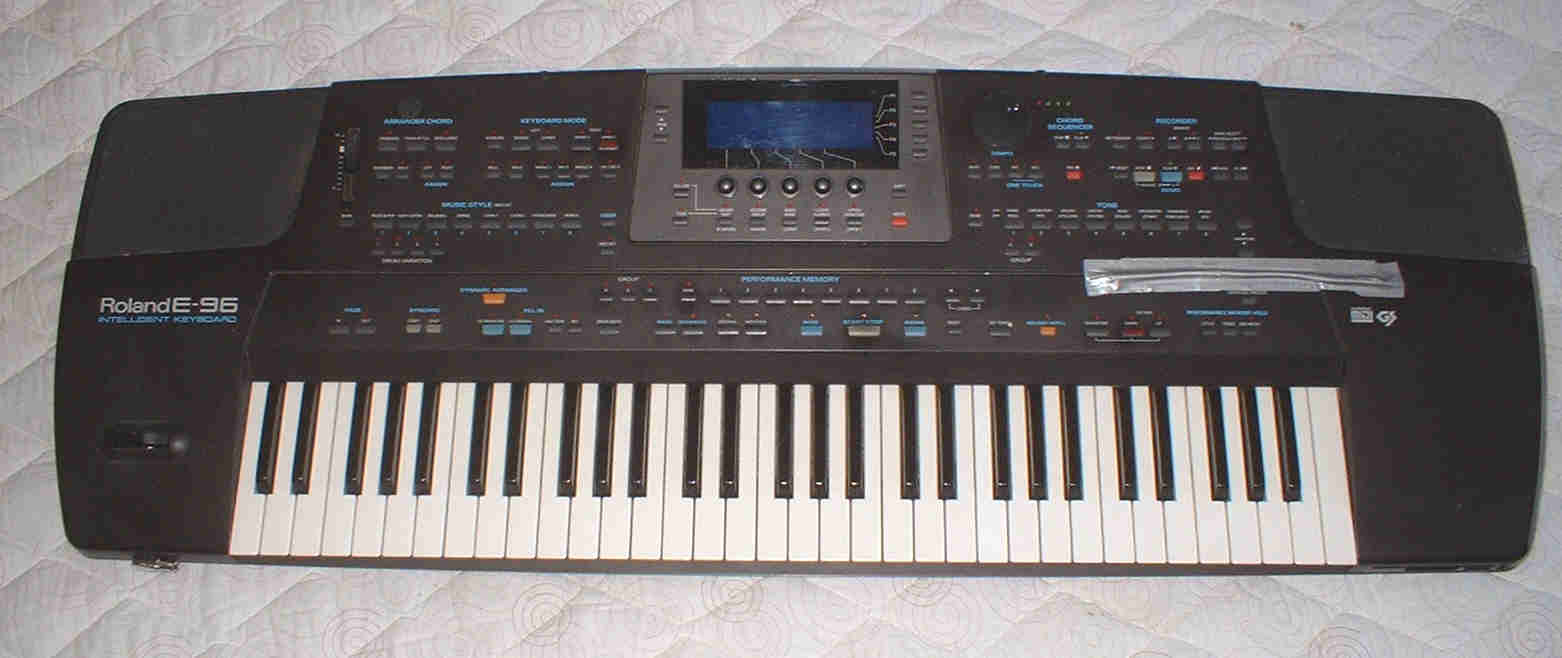Foto: Kurt Starlit
ROLAND
E-96
Poly Synth
The Roland E-20 is a keyboard instrument introduced by Roland in 1988.
Described by Roland as an "Intelligent Synthesizer", the instrument was the first product of Roland Europe SpA, which had been set up after a takeover of the SIEL company of Italy the previous year. The new venture was a strategic move by Roland to enter the lucrative home keyboard market which had hitherto been dominated by both Yamaha and Casio.
Featuring auto accompaniment, and built in speakers the E-20 used the advanced LA Synthesis system as used on the legendary Roland D-50 its core sound engine. The E-20 set a new standard for the amateur keyboardist, with high-quality sounds, innovative drum patterns and backings which were widely recognised as being a jump ahead of Yamaha's competing PSR line.
As well as the E-20 itself, the cheaper E-5 and E-10 were subsequently launched as "cut down" versions, while the enhanced E-30 debuted in 1990. There was also a modular version (the RA-50 Realtime Arranger), and the Pro-E Intelligent Arranger, which was basically half an E-20 minus speakers with only the arranger and drum unit.
Roland would go on to dominate the home keyboard market in the 1990s with subsequent generations of the E-series line, and would later introduce the closely related professional G-series line (the G-800, G-1000 and later, the G-70) as auto accompaniment began to gain acceptance and recognition within the high-end user community. However, all of these products retain the same basic architecture of the E-20.
Generations of Roland Home Keyboards
First Generation (Produced 1988-1991):
E-5, E-10, E-20, E-30, RA-50, Pro-E Arranger
Second Generation (Produced 1991-1993):
E-15, E-35, E-70, RA-90
Third Generation (Produced 1993-1996):
E-16, E-36, E-56, E-86, RA-95
Fourth Generation (Produced 1995/6 - 1998):
E-28, E-68, E-96, G-800, RA-900
Fifth Generation (Produced 1998 - 2001):
EM-2000, EM-50, EM-30, E-500, G-1000
ref.:
http://en.wikipedia.org/wiki/Roland_E-20
============================================
E-96 / pol syn 3395 (1995)
Das neueste Topmodell der E-Reihe ist nochmals überarbeitet und erweitert worden.
Als zentraler Blickfang fungiert ein grafikfähiges Display mit sechs darunter angeordneten Drehreglern, über welchem auch eine Klangeditierung möglich ist. Das eingebaute 3,5" Diskettenlaufwerk fungiert zugleich als SMF-Player und -Recorder.
Natürlich sind Sequenzer und Begleitautomatik in der E-Reihe schon selbstverständlich. E-86-Styles bleiben auch im E-96 weiterhin einsetzbar und kompatibel. Als Basis dienen im E-96 gleich 241 verschiedenen Klänge, sowie acht Drumsets und das obligatorische SFX-Set. Die Tastatur umfasst 61 anschlagsdynamische Tasten. Die Klangerzeugung ist 28-stimmig polyphon und 16-fach multitimbral. Chorus- und Hall-Effekte runden die GS-Mindestausstattung ab. Gleich vier Verstärker (je zwei 7,5 und 15 Watt) und vier Lautsprecher (zwei 8,5 cm und zwei 16,5 cm) sorgen für die Wiedergabe.
ref.:
http://www.synrise.de/docs/types/r/roland/roland_e-serie2.htm
============================================
Specifikationer
Keyboard:
61 tangenter,
anslagsfølsomme (følsomheden kan justeres),
synth.typen
Lydmodul:
TVF (GM/GS format)
Polyfoni:
28 toners polyfoni
Lyde:
Du kan vælge mellem 241 lyde.
Trommesæt:
8 trommesæt
Synthesizer redigering:
Vib. rate
Vib. depth
Vib. delay
Cutoff freq.
Resonance
Attack Time
Decay Time
Release Time
Music Style:
64 akkompagnementsstilarter
User Style:
8 programmerbare User Styles (8 spor pr. styles)
Performance memory:
192 stk.
MIDI set:
8 stk.
Recorder:
Indspiller direkte på diskette (standard MIDI-filer).
Effekter:
Reverb og Chorus (Realtime-part)
Diskettedrev:
SMF-afspiller.
User Style,
User Style Set,
Performance Memory,
MIDI Set,
Chord Sequence.
3,5" diskettedrev.
Display:
Grafisk 240 x 64 pixels, baglys LCD.
Kontrastknap bag på instrumentet
Tilslutninger:
Hovedtelefoner
RCC-stik
Output L - mono / R
Input L - mono / R
Sustain
Footswitch
Exp. pedal
Multi Footswitch bøsning
Pedal-bøsning for FC-7 pedal
MIDI In, MIDI Out, MIDI through
AC In - bøsning
Størrelse:
1175 mm bredt
413 mm dybt
133 mm højt
Vægt:
14,5 kg.
ref.
Roland, Dansk Brugsanvisning
